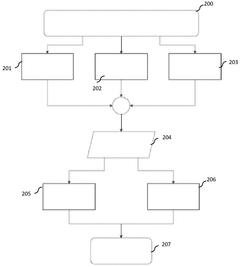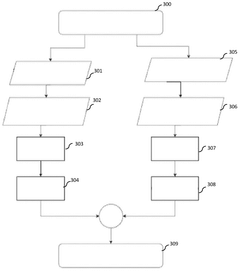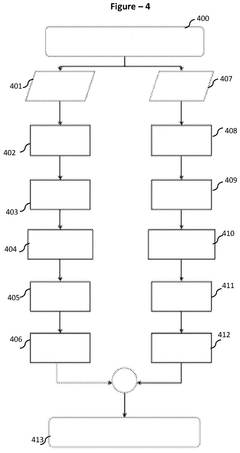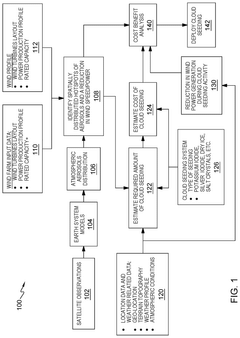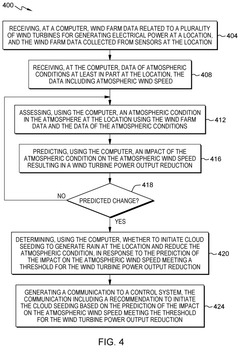Enhancing Solar Inverter Functionality with AI Tools?
JUL 17, 202510 MIN READ
Generate Your Research Report Instantly with AI Agent
Patsnap Eureka helps you evaluate technical feasibility & market potential.
AI-Enhanced Solar Inverter Evolution and Objectives
The evolution of solar inverter technology has been marked by significant advancements in efficiency, reliability, and functionality. As the solar energy sector continues to grow, the integration of Artificial Intelligence (AI) tools into solar inverter systems represents a pivotal development in this field. This technological convergence aims to enhance the overall performance and capabilities of solar power systems, addressing key challenges in energy conversion, grid integration, and system management.
The primary objective of incorporating AI into solar inverters is to optimize energy production and distribution. By leveraging machine learning algorithms and predictive analytics, AI-enhanced inverters can adapt to varying environmental conditions, anticipate fluctuations in power generation, and adjust their operations accordingly. This dynamic responsiveness contributes to improved system efficiency and longevity, ultimately reducing the levelized cost of energy (LCOE) for solar installations.
Another crucial goal is to enhance grid stability and reliability. As the penetration of renewable energy sources increases, maintaining grid balance becomes more complex. AI-powered inverters can provide advanced grid support functions, such as reactive power control, voltage regulation, and frequency response. These capabilities are essential for ensuring seamless integration of solar power into existing electrical grids and supporting the transition towards smart grid infrastructures.
Predictive maintenance is a key objective in the development of AI-enhanced solar inverters. By continuously monitoring system performance and analyzing operational data, AI algorithms can detect potential issues before they escalate into major problems. This proactive approach to maintenance can significantly reduce downtime, extend equipment lifespan, and optimize maintenance schedules, resulting in substantial cost savings for system operators.
Furthermore, the integration of AI aims to improve energy forecasting and management. Advanced machine learning models can analyze historical data, weather patterns, and real-time sensor inputs to provide accurate predictions of solar power generation. This enhanced forecasting capability enables better planning and coordination with grid operators, facilitating more efficient energy distribution and storage strategies.
As the solar industry moves towards more decentralized and complex energy systems, AI-enhanced inverters are expected to play a crucial role in enabling peer-to-peer energy trading and virtual power plant (VPP) configurations. The objective is to create more resilient and flexible energy networks that can dynamically respond to supply and demand fluctuations, maximizing the utilization of renewable energy resources.
In conclusion, the evolution of AI-enhanced solar inverters represents a significant leap forward in solar energy technology. By addressing key challenges and unlocking new possibilities in energy management, these advanced systems are poised to accelerate the global transition to sustainable energy sources, contributing to a more efficient, reliable, and environmentally friendly power infrastructure.
The primary objective of incorporating AI into solar inverters is to optimize energy production and distribution. By leveraging machine learning algorithms and predictive analytics, AI-enhanced inverters can adapt to varying environmental conditions, anticipate fluctuations in power generation, and adjust their operations accordingly. This dynamic responsiveness contributes to improved system efficiency and longevity, ultimately reducing the levelized cost of energy (LCOE) for solar installations.
Another crucial goal is to enhance grid stability and reliability. As the penetration of renewable energy sources increases, maintaining grid balance becomes more complex. AI-powered inverters can provide advanced grid support functions, such as reactive power control, voltage regulation, and frequency response. These capabilities are essential for ensuring seamless integration of solar power into existing electrical grids and supporting the transition towards smart grid infrastructures.
Predictive maintenance is a key objective in the development of AI-enhanced solar inverters. By continuously monitoring system performance and analyzing operational data, AI algorithms can detect potential issues before they escalate into major problems. This proactive approach to maintenance can significantly reduce downtime, extend equipment lifespan, and optimize maintenance schedules, resulting in substantial cost savings for system operators.
Furthermore, the integration of AI aims to improve energy forecasting and management. Advanced machine learning models can analyze historical data, weather patterns, and real-time sensor inputs to provide accurate predictions of solar power generation. This enhanced forecasting capability enables better planning and coordination with grid operators, facilitating more efficient energy distribution and storage strategies.
As the solar industry moves towards more decentralized and complex energy systems, AI-enhanced inverters are expected to play a crucial role in enabling peer-to-peer energy trading and virtual power plant (VPP) configurations. The objective is to create more resilient and flexible energy networks that can dynamically respond to supply and demand fluctuations, maximizing the utilization of renewable energy resources.
In conclusion, the evolution of AI-enhanced solar inverters represents a significant leap forward in solar energy technology. By addressing key challenges and unlocking new possibilities in energy management, these advanced systems are poised to accelerate the global transition to sustainable energy sources, contributing to a more efficient, reliable, and environmentally friendly power infrastructure.
Market Demand Analysis for Smart Solar Inverters
The market demand for smart solar inverters integrated with AI tools is experiencing significant growth, driven by the increasing adoption of renewable energy sources and the need for more efficient and intelligent energy management systems. As the global push for clean energy intensifies, solar power has emerged as a key player in the renewable energy landscape. This shift has created a robust demand for advanced solar inverter technologies that can optimize energy production, storage, and distribution.
Smart solar inverters enhanced with AI capabilities offer numerous advantages over traditional inverters, including improved energy conversion efficiency, predictive maintenance, and adaptive grid integration. These features are particularly attractive to both residential and commercial consumers looking to maximize their return on investment in solar energy systems. The ability of AI-powered inverters to analyze and respond to real-time data on weather conditions, energy consumption patterns, and grid stability has positioned them as essential components in the evolving smart grid infrastructure.
The market for smart solar inverters is also being propelled by government initiatives and regulations aimed at promoting renewable energy adoption and grid modernization. Many countries have implemented policies that incentivize the installation of solar power systems, creating a favorable environment for the growth of smart inverter technologies. Additionally, utilities and grid operators are increasingly recognizing the value of AI-enhanced inverters in managing the complexities of integrating distributed energy resources into the existing power infrastructure.
In the residential sector, the demand for smart solar inverters is driven by homeowners' desire for greater energy independence and cost savings. AI-powered inverters can optimize energy consumption by intelligently managing power flow between solar panels, battery storage systems, and household appliances. This level of control allows homeowners to reduce their reliance on the grid and potentially sell excess energy back to utilities, creating new revenue streams.
The commercial and industrial sectors represent another significant market for smart solar inverters. Large-scale solar installations in these sectors benefit greatly from AI-enhanced inverters that can maximize energy yield, reduce downtime through predictive maintenance, and ensure compliance with grid regulations. The ability of these inverters to provide detailed analytics and performance data is particularly valuable for businesses looking to optimize their energy investments and meet sustainability goals.
As the Internet of Things (IoT) and edge computing technologies continue to advance, the integration of AI into solar inverters is expected to become even more sophisticated. This evolution will likely lead to increased demand for inverters capable of seamless communication with other smart devices and energy management systems, further driving market growth in the coming years.
Smart solar inverters enhanced with AI capabilities offer numerous advantages over traditional inverters, including improved energy conversion efficiency, predictive maintenance, and adaptive grid integration. These features are particularly attractive to both residential and commercial consumers looking to maximize their return on investment in solar energy systems. The ability of AI-powered inverters to analyze and respond to real-time data on weather conditions, energy consumption patterns, and grid stability has positioned them as essential components in the evolving smart grid infrastructure.
The market for smart solar inverters is also being propelled by government initiatives and regulations aimed at promoting renewable energy adoption and grid modernization. Many countries have implemented policies that incentivize the installation of solar power systems, creating a favorable environment for the growth of smart inverter technologies. Additionally, utilities and grid operators are increasingly recognizing the value of AI-enhanced inverters in managing the complexities of integrating distributed energy resources into the existing power infrastructure.
In the residential sector, the demand for smart solar inverters is driven by homeowners' desire for greater energy independence and cost savings. AI-powered inverters can optimize energy consumption by intelligently managing power flow between solar panels, battery storage systems, and household appliances. This level of control allows homeowners to reduce their reliance on the grid and potentially sell excess energy back to utilities, creating new revenue streams.
The commercial and industrial sectors represent another significant market for smart solar inverters. Large-scale solar installations in these sectors benefit greatly from AI-enhanced inverters that can maximize energy yield, reduce downtime through predictive maintenance, and ensure compliance with grid regulations. The ability of these inverters to provide detailed analytics and performance data is particularly valuable for businesses looking to optimize their energy investments and meet sustainability goals.
As the Internet of Things (IoT) and edge computing technologies continue to advance, the integration of AI into solar inverters is expected to become even more sophisticated. This evolution will likely lead to increased demand for inverters capable of seamless communication with other smart devices and energy management systems, further driving market growth in the coming years.
Current AI Integration Challenges in Solar Inverters
The integration of AI tools into solar inverters presents several significant challenges that need to be addressed for successful implementation. One of the primary obstacles is the complexity of developing AI algorithms capable of accurately predicting and optimizing solar energy production under varying environmental conditions. These algorithms must account for factors such as weather patterns, shading effects, and panel degradation, which require extensive data collection and processing capabilities.
Another challenge lies in the hardware limitations of current solar inverter systems. Many existing inverters lack the computational power necessary to run sophisticated AI models in real-time. Upgrading these systems to accommodate AI functionality often involves significant costs and potential disruptions to existing solar installations.
Data quality and availability pose additional hurdles. AI models require large amounts of high-quality, diverse data to train effectively. However, collecting comprehensive data from distributed solar installations can be challenging due to privacy concerns, inconsistent data formats, and the need for robust communication infrastructure.
Ensuring the reliability and stability of AI-enhanced solar inverters is crucial. The integration of AI must not compromise the core functionality of the inverter or introduce vulnerabilities that could lead to system failures or reduced energy output. Rigorous testing and validation processes are necessary to guarantee the seamless operation of AI features alongside traditional inverter functions.
Cybersecurity is another critical concern in AI integration. As solar inverters become more intelligent and connected, they become potential targets for cyberattacks. Implementing robust security measures to protect sensitive data and prevent unauthorized access to AI-controlled systems is essential but challenging.
The lack of standardization in AI implementation for solar inverters presents obstacles for widespread adoption. Different manufacturers may develop proprietary AI solutions, leading to interoperability issues and hindering the creation of a unified ecosystem for AI-enhanced solar energy systems.
Regulatory compliance and certification pose additional challenges. As AI technologies are integrated into solar inverters, new regulations and standards may be required to ensure safety, reliability, and fair market practices. Navigating these evolving regulatory landscapes can be complex and time-consuming for manufacturers and developers.
Lastly, there is a significant skills gap in the solar energy industry when it comes to AI expertise. Developing, implementing, and maintaining AI-enhanced solar inverters requires a workforce with specialized knowledge in both solar technology and artificial intelligence. Bridging this skills gap through training and education programs is essential for the successful integration of AI into solar inverter systems.
Another challenge lies in the hardware limitations of current solar inverter systems. Many existing inverters lack the computational power necessary to run sophisticated AI models in real-time. Upgrading these systems to accommodate AI functionality often involves significant costs and potential disruptions to existing solar installations.
Data quality and availability pose additional hurdles. AI models require large amounts of high-quality, diverse data to train effectively. However, collecting comprehensive data from distributed solar installations can be challenging due to privacy concerns, inconsistent data formats, and the need for robust communication infrastructure.
Ensuring the reliability and stability of AI-enhanced solar inverters is crucial. The integration of AI must not compromise the core functionality of the inverter or introduce vulnerabilities that could lead to system failures or reduced energy output. Rigorous testing and validation processes are necessary to guarantee the seamless operation of AI features alongside traditional inverter functions.
Cybersecurity is another critical concern in AI integration. As solar inverters become more intelligent and connected, they become potential targets for cyberattacks. Implementing robust security measures to protect sensitive data and prevent unauthorized access to AI-controlled systems is essential but challenging.
The lack of standardization in AI implementation for solar inverters presents obstacles for widespread adoption. Different manufacturers may develop proprietary AI solutions, leading to interoperability issues and hindering the creation of a unified ecosystem for AI-enhanced solar energy systems.
Regulatory compliance and certification pose additional challenges. As AI technologies are integrated into solar inverters, new regulations and standards may be required to ensure safety, reliability, and fair market practices. Navigating these evolving regulatory landscapes can be complex and time-consuming for manufacturers and developers.
Lastly, there is a significant skills gap in the solar energy industry when it comes to AI expertise. Developing, implementing, and maintaining AI-enhanced solar inverters requires a workforce with specialized knowledge in both solar technology and artificial intelligence. Bridging this skills gap through training and education programs is essential for the successful integration of AI into solar inverter systems.
Existing AI Solutions for Solar Inverter Optimization
01 Power conversion and grid integration
Solar inverters convert DC power from solar panels to AC power for grid use. They ensure synchronization with the grid frequency and voltage, and manage power flow between the solar system and the electrical grid. Advanced inverters can also provide grid support functions like voltage regulation and reactive power control.- Power conversion and grid integration: Solar inverters convert DC power from solar panels to AC power for grid integration. They manage voltage and frequency synchronization, ensuring seamless power delivery to the electrical grid. Advanced inverters also provide grid support functions like reactive power control and voltage regulation.
- Maximum Power Point Tracking (MPPT): Solar inverters employ MPPT algorithms to optimize power output from solar panels. These algorithms continuously adjust the operating point of the panels to extract maximum power under varying environmental conditions, such as changes in sunlight intensity or temperature.
- Monitoring and diagnostics: Modern solar inverters incorporate advanced monitoring and diagnostic capabilities. They collect and analyze data on system performance, energy production, and potential faults. This information can be accessed remotely, allowing for efficient maintenance and troubleshooting of solar power systems.
- Safety and protection features: Solar inverters include various safety and protection mechanisms. These features protect the inverter and connected equipment from electrical faults, overvoltage, overcurrent, and other potentially harmful conditions. They also ensure compliance with grid interconnection standards and rapid shutdown requirements.
- Smart grid integration and energy management: Advanced solar inverters support smart grid functionalities, enabling bidirectional communication with the grid. They can participate in demand response programs, manage energy storage systems, and optimize self-consumption of solar energy. These features contribute to grid stability and efficient energy utilization.
02 Maximum Power Point Tracking (MPPT)
Solar inverters employ MPPT algorithms to optimize power output from solar panels. These algorithms continuously adjust the operating point of the panels to extract maximum power under varying environmental conditions such as temperature and irradiance levels.Expand Specific Solutions03 Monitoring and communication
Modern solar inverters include advanced monitoring and communication capabilities. They can collect and transmit data on system performance, energy production, and fault detection. Many inverters offer remote monitoring and control features, allowing users and operators to access real-time information and manage the system remotely.Expand Specific Solutions04 Safety and protection features
Solar inverters incorporate various safety and protection mechanisms. These include anti-islanding protection to prevent power feed into a de-energized grid, ground fault detection, surge protection, and automatic shutdown in case of system faults or grid irregularities. Advanced inverters also feature arc fault detection to mitigate fire risks.Expand Specific Solutions05 Smart grid integration and energy management
Advanced solar inverters support smart grid functionalities, enabling better integration of distributed energy resources. They can participate in demand response programs, provide grid services, and facilitate energy storage integration. Some inverters also offer energy management features, allowing users to optimize self-consumption and reduce reliance on grid power.Expand Specific Solutions
Key Players in AI-Powered Solar Inverter Industry
The market for enhancing solar inverter functionality with AI tools is in a growth phase, driven by increasing demand for smart energy solutions. The global solar inverter market is projected to reach significant size in the coming years, with AI integration expected to play a crucial role. Technologically, the field is rapidly evolving, with companies like Fronius International GmbH, Siemens AG Österreich, and Huawei Digital Power Technologies Co Ltd leading innovation. These firms are developing advanced AI-powered inverters that optimize energy conversion, improve grid stability, and enhance overall system performance. The competitive landscape is diverse, featuring established electrical engineering giants and specialized solar technology firms, all vying to leverage AI for more efficient and intelligent solar energy systems.
Advanced Energy Industries, Inc.
Technical Solution: Advanced Energy's approach to enhancing solar inverter functionality with AI tools focuses on improving overall system performance and reliability. Their solution incorporates machine learning algorithms for optimized maximum power point tracking (MPPT), adapting to various environmental conditions and panel configurations[1]. Advanced Energy's inverters utilize AI for predictive maintenance, analyzing performance data to anticipate potential issues and schedule maintenance proactively[2]. The company has developed AI-driven power optimization techniques that integrate with their inverters, maximizing energy yield across diverse operating conditions[3]. Their inverters also feature AI-enhanced grid integration capabilities, ensuring smooth power output and improved grid stability in compliance with evolving standards[4]. Additionally, Advanced Energy's AI tools facilitate better energy management by predicting solar generation and optimizing power flow between generation, storage, and consumption[5].
Strengths: Robust MPPT optimization, focus on predictive maintenance and power optimization. Weaknesses: May have higher initial costs compared to traditional inverters due to advanced AI features.
ABB Group
Technical Solution: ABB's approach to enhancing solar inverter functionality with AI tools centers on their ABB Ability™ platform. This system integrates machine learning algorithms to optimize inverter performance and energy yield[1]. ABB's AI-driven inverters use advanced data analytics to improve power conversion efficiency and adapt to changing environmental conditions[2]. The company has developed AI-based forecasting models that predict solar output, enabling better grid management and energy storage integration[3]. ABB's inverters also incorporate self-learning capabilities for fault detection and predictive maintenance, reducing downtime and maintenance costs[4]. Furthermore, their AI tools enable dynamic power factor correction and voltage regulation, enhancing grid stability and compliance with evolving grid codes[5].
Strengths: Comprehensive AI integration across multiple inverter functions, strong focus on grid stability and compliance. Weaknesses: Complexity of the system may require specialized training for installation and maintenance.
Core AI Innovations in Solar Energy Conversion
Artificial intelligence supported solar power plant photovoltaic panel inspection system and its method
PatentWO2025090050A1
Innovation
- An AI-supported system that uses thermal and RGB images from UAVs to perform pixel-based thermal examinations, convert 2D images to 3D models, and conduct real-time solar simulations and navigation analyses to detect defects and optimize energy generation.
Computational analysis for evaluation of localized atmospheric conditions to enhance atmospheric dependent electrical power generation
PatentPendingUS20250130347A1
Innovation
- The use of artificial intelligence to evaluate localized atmospheric conditions and implement cloud seeding techniques to reduce aerosol concentrations, thereby increasing wind speeds and enhancing wind power generation.
Regulatory Framework for AI in Renewable Energy
The integration of Artificial Intelligence (AI) tools in solar inverter technology has necessitated the development of a comprehensive regulatory framework to ensure safe, ethical, and efficient implementation. As the renewable energy sector increasingly adopts AI-driven solutions, governments and regulatory bodies worldwide are working to establish guidelines that address the unique challenges posed by this technological convergence.
At the forefront of these regulatory efforts is the need to ensure data privacy and security. AI-enhanced solar inverters collect and process vast amounts of sensitive information, including energy consumption patterns and grid performance data. Regulations are being developed to mandate robust data protection measures, including encryption standards, access controls, and data retention policies. These guidelines aim to safeguard consumer information and prevent unauthorized access or misuse of critical energy infrastructure data.
Another key aspect of the regulatory framework focuses on the reliability and safety of AI-driven solar inverter systems. Authorities are implementing certification processes and performance standards to verify the accuracy and dependability of AI algorithms used in inverter control and optimization. These regulations often require rigorous testing and validation procedures to ensure that AI-enhanced inverters can operate safely under various grid conditions and maintain stability during unexpected events.
Interoperability and standardization are also crucial components of the regulatory landscape. As AI tools become more prevalent in solar inverter technology, there is a growing need for common protocols and interfaces to facilitate seamless integration with existing grid infrastructure. Regulatory bodies are working to establish industry-wide standards that promote compatibility and enable efficient communication between different AI-enhanced inverter systems and grid operators.
The ethical implications of AI in renewable energy systems are also being addressed through regulatory measures. Guidelines are being developed to ensure transparency in AI decision-making processes, particularly in scenarios where AI algorithms control energy distribution or pricing. These regulations aim to prevent discriminatory practices and ensure fair access to renewable energy resources for all consumers.
Furthermore, the regulatory framework is evolving to address the potential environmental impact of AI-enhanced solar inverters. This includes considerations for the lifecycle management of AI-enabled hardware, energy consumption of AI systems, and the responsible sourcing of materials used in advanced inverter technologies. Regulations are being crafted to promote sustainable practices in the development and deployment of these innovative solutions.
As the field of AI in renewable energy continues to advance, regulatory frameworks are designed to be adaptable and forward-looking. Many jurisdictions are implementing mechanisms for regular review and updates to their regulations, ensuring that they remain relevant and effective in the face of rapid technological progress. This approach allows for the incorporation of new insights and best practices as the industry gains more experience with AI-enhanced solar inverter systems.
At the forefront of these regulatory efforts is the need to ensure data privacy and security. AI-enhanced solar inverters collect and process vast amounts of sensitive information, including energy consumption patterns and grid performance data. Regulations are being developed to mandate robust data protection measures, including encryption standards, access controls, and data retention policies. These guidelines aim to safeguard consumer information and prevent unauthorized access or misuse of critical energy infrastructure data.
Another key aspect of the regulatory framework focuses on the reliability and safety of AI-driven solar inverter systems. Authorities are implementing certification processes and performance standards to verify the accuracy and dependability of AI algorithms used in inverter control and optimization. These regulations often require rigorous testing and validation procedures to ensure that AI-enhanced inverters can operate safely under various grid conditions and maintain stability during unexpected events.
Interoperability and standardization are also crucial components of the regulatory landscape. As AI tools become more prevalent in solar inverter technology, there is a growing need for common protocols and interfaces to facilitate seamless integration with existing grid infrastructure. Regulatory bodies are working to establish industry-wide standards that promote compatibility and enable efficient communication between different AI-enhanced inverter systems and grid operators.
The ethical implications of AI in renewable energy systems are also being addressed through regulatory measures. Guidelines are being developed to ensure transparency in AI decision-making processes, particularly in scenarios where AI algorithms control energy distribution or pricing. These regulations aim to prevent discriminatory practices and ensure fair access to renewable energy resources for all consumers.
Furthermore, the regulatory framework is evolving to address the potential environmental impact of AI-enhanced solar inverters. This includes considerations for the lifecycle management of AI-enabled hardware, energy consumption of AI systems, and the responsible sourcing of materials used in advanced inverter technologies. Regulations are being crafted to promote sustainable practices in the development and deployment of these innovative solutions.
As the field of AI in renewable energy continues to advance, regulatory frameworks are designed to be adaptable and forward-looking. Many jurisdictions are implementing mechanisms for regular review and updates to their regulations, ensuring that they remain relevant and effective in the face of rapid technological progress. This approach allows for the incorporation of new insights and best practices as the industry gains more experience with AI-enhanced solar inverter systems.
Environmental Impact of AI-Enhanced Solar Inverters
The integration of AI tools into solar inverter systems presents a significant opportunity to enhance their environmental impact. By optimizing energy conversion and distribution, AI-enhanced solar inverters can contribute to increased renewable energy utilization and reduced carbon emissions. These advanced systems can adapt to varying weather conditions, predict energy generation patterns, and efficiently manage power flow, leading to improved overall system performance.
One of the primary environmental benefits of AI-enhanced solar inverters is their ability to maximize energy harvest from solar panels. Through intelligent algorithms, these systems can continuously adjust inverter parameters to match the optimal operating conditions, ensuring that the maximum amount of solar energy is captured and converted into usable electricity. This increased efficiency translates directly into reduced reliance on fossil fuel-based energy sources, thereby lowering greenhouse gas emissions.
AI-powered inverters also contribute to grid stability and reliability. By accurately forecasting solar energy production based on weather data and historical patterns, these systems can better balance supply and demand, reducing the need for backup power from non-renewable sources. This improved grid management can lead to a more resilient and sustainable energy infrastructure, supporting the broader adoption of renewable energy technologies.
Furthermore, AI-enhanced inverters can extend the lifespan of solar energy systems through predictive maintenance capabilities. By monitoring system performance and identifying potential issues before they escalate, these intelligent inverters can prevent equipment failures and minimize downtime. This not only ensures consistent energy production but also reduces the environmental impact associated with manufacturing and replacing solar system components.
The integration of AI into solar inverters also enables more effective energy storage management. By analyzing consumption patterns and predicting energy needs, these systems can optimize the charging and discharging of battery storage systems, maximizing the use of locally generated solar power and reducing reliance on grid electricity during peak demand periods. This load shifting capability can significantly decrease the carbon footprint of energy consumption.
Lastly, AI-enhanced solar inverters can play a crucial role in supporting the development of smart grids and virtual power plants. By facilitating seamless communication between distributed energy resources, these systems can enable more efficient energy distribution and utilization across entire communities. This collective approach to energy management can lead to substantial reductions in overall energy consumption and associated environmental impacts.
One of the primary environmental benefits of AI-enhanced solar inverters is their ability to maximize energy harvest from solar panels. Through intelligent algorithms, these systems can continuously adjust inverter parameters to match the optimal operating conditions, ensuring that the maximum amount of solar energy is captured and converted into usable electricity. This increased efficiency translates directly into reduced reliance on fossil fuel-based energy sources, thereby lowering greenhouse gas emissions.
AI-powered inverters also contribute to grid stability and reliability. By accurately forecasting solar energy production based on weather data and historical patterns, these systems can better balance supply and demand, reducing the need for backup power from non-renewable sources. This improved grid management can lead to a more resilient and sustainable energy infrastructure, supporting the broader adoption of renewable energy technologies.
Furthermore, AI-enhanced inverters can extend the lifespan of solar energy systems through predictive maintenance capabilities. By monitoring system performance and identifying potential issues before they escalate, these intelligent inverters can prevent equipment failures and minimize downtime. This not only ensures consistent energy production but also reduces the environmental impact associated with manufacturing and replacing solar system components.
The integration of AI into solar inverters also enables more effective energy storage management. By analyzing consumption patterns and predicting energy needs, these systems can optimize the charging and discharging of battery storage systems, maximizing the use of locally generated solar power and reducing reliance on grid electricity during peak demand periods. This load shifting capability can significantly decrease the carbon footprint of energy consumption.
Lastly, AI-enhanced solar inverters can play a crucial role in supporting the development of smart grids and virtual power plants. By facilitating seamless communication between distributed energy resources, these systems can enable more efficient energy distribution and utilization across entire communities. This collective approach to energy management can lead to substantial reductions in overall energy consumption and associated environmental impacts.
Unlock deeper insights with Patsnap Eureka Quick Research — get a full tech report to explore trends and direct your research. Try now!
Generate Your Research Report Instantly with AI Agent
Supercharge your innovation with Patsnap Eureka AI Agent Platform!

